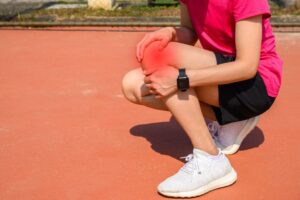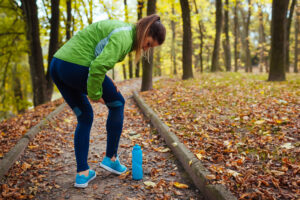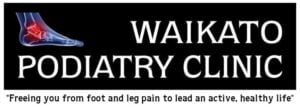Runner’s Knee and Hip Pain
 What is Runner's Knee and Hip Pain?
What is Runner's Knee and Hip Pain?
The Iliotibial band (ITB) is a large fibrous structure which runs from high up on the hip, down the outside of your leg, to insert into the lower leg (tibia), just below the knee joint. The ITB can be felt by bending the leg and running your fingers down the outside of your leg, stopping at the knee. The main function of this structure is to stabilise the knee and hip. It also helps to control the internal rotation of the lower limb.
Iliotibial Band Friction Syndrome (IBFS) occurs when there is an irritation or inflammation of the ITB as it rounds the outside of the hip or knee. At these points, there are small sacs of fluid (bursa) which are designed to reduce the friction between the bone and the fascia or ITB. This may also become inflamed compounding the problem.
How do I know if I have Runner's Knee and Hip Pain?
The knee is a complex weight-bearing joint, and a thorough assessment is required to diagnose this problem.
The ITB rubs against the thigh bone or “femur” with great pressure at certain times. This tenderness often occurs when the foot hits the ground and the knee begins to bend slightly. This process develops what is known as an ‘Impingement Zone’ in the ITB, or simply a small area that is acutely painful when pressure is applied to it or the knee flexes to about 30degrees.
 What Causes Runner's Knee and Hip Pain?
What Causes Runner's Knee and Hip Pain?
There have been several studies on ITBS which have tried to isolate an exact cause, but unfortunately, these have failed to isolate a single causative factor. It is important to remember that it is often hard to establish a direct cause and effect relationship with many injuries, as they often involve a combination of several different risk factors.
Increasing running too quickly or changing the terrain too fast are frequent contributors to this problem.
Possible Risk Factors:
- Training errors – sudden increases in the amount of running or a sudden change in the training terrain, such as running more on hills can result in ITBFS. Interestingly, longer, slower running is thought to be more problematic in ITBFS than shorter, harder runs or multidirectional sports.
- Poor lower limb bio-mechanics – this includes such anomalies as increased movement in the feet (hyper pronation), excessive bowing of the legs or a leg length discrepancy. These are a few of the many possible problems in this area.
- Muscle weakness or imbalance – the muscles that insert into the ITB can become weakened or out of balance, and this situation has the effect of altering the alignment of the ITB adding to the friction problems.
- Footwear – wearing footwear that is not suited to your foot type or is excessively worn may also contribute to ITBFS.
How can it be treated?
As with most injuries, in the early stages, reducing aggravating activities and icing of the sore area is a good first step. This should be followed up with a positive diagnosis from a Podiatrist at Waikato Podiatry Clinic.
Long Term Solution:
When the foot pronates, the lower leg internally rotates, relative to the thigh. This is thought to increase the rubbing of the ITB where the impingement and pain is occurring at either the hip, or outside of the knee. Podiatry assessment will focus on screening the lower limb and shoes for any of the predisposing factors. This is done through a footwear check and bio-mechanical assessment and video gait analysis. If excessive pronation of the foot is thought to be contributing to the problem, some type of shoe inserts or bio-mechanical orthotic may be able to support the problem. Strengthening the support muscles around the hip is very important to correct this common problem also.
Still in Pain?
Are you are feeling like you have tried everything but are still in pain?
Do you feel like you have seen every health practitioner you can about your knee and hip pain?
We have a track record of diagnosing and successfully treating cases that have previously proven difficult to resolve and we’d love to help you get back on your feet doing what you love.

 What is Runner's Knee and Hip Pain?
What is Runner's Knee and Hip Pain? What Causes Runner's Knee and Hip Pain?
What Causes Runner's Knee and Hip Pain?